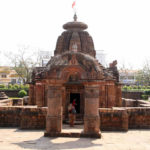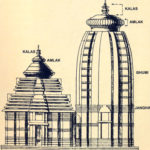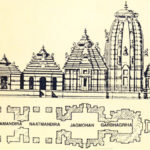Orissa is a land of temples. The concentration of the largest number of temples all over the state has made it a centre of unique attraction for scholars, Indologists, tourists and others. Out of the five different types of architecture, that is: devotional, memorial, civil, military and domestic, we mainly come across the devotional type of architecture in Orissa. Others have disappeared with the ravages of time and power.
Temples as free standing structures came to Orissa after the Gupta period, through Dakshina Kosala. The Hindu hegemony of Bhaumakaras, Somavamsis and Gangas inspired the Orissan architects to carry on the spirit of creating their own style of architectural temple representations without any Islamic or Persian influence. The period thus ranges from 6th century A.D. to 16th century A.D.
The builders of the Orissan temples gave vent to their feelings on the basis of indigenous canonical texts like Bhuban Pradip, Silpapothi, Silpasastra, Vastusastra Upanisad, Silparatnakara, Silpasarini, Silpa Prakash, Padma Kesara, Deula Mapagunagara, Bhuban Prabesh, Soudhikagama, etc., indicating the standard achieved by our ancestors in the field of temple architecture.
The Indian temples in general are divided into three categories based on their geographical location and peculiar features:
- the Northern Indian temples branded as Nagara style of Architecture
- the temples of Deccan belong to the Vesara style
- the Dravida style found in South India.
The Orissan temple architecture ranging from 7th to 13th century A.D., however, corresponds to an altogether different category. Their unique representations are called Kalingan style of temple architecture. Though broadly they come under the Northern or Nagara style, they have certain special features which are uniquely their own.
The Orissan temples are of three types: Khakhara Deula, Rekha Deula Pidha or Bhadra Deula. The Khakhara Deula is altogether a different style of architecture appearing closely similar to the Dravidian Gopuram design. The word is derived from kakharu (pumpkin, gourd) as the crown looks like a barrel-vaulted elongated roof.
The Sakta temples are generally of Khakhara order. Varahi temple of Chaurasi in Puri district and Gouri temple of Bhubaneswar are two clear examples of Khakhara temple. Other Saivite and Vaisnavite temples in Orissa represent both Rekha and Pidha types.
In the formative period of Orissan temple architecture there were only two structures of temples. The first is original sanctum or Vimana or Bada Deula. The second is Jagamohana or Mukhasala. The sanctum of the temple is of Rekha order, having a curvilinear superstructure. But the Jagamohana standing before the main structure is of Pidha order. The Pidhas form several tiers sitting one upon the other, rising to a pinnacle. With the march of time the Oriya architects began to invent new forms of structure. Thus in big temples we find four structures:
- Vimana, or Bada Deula Jagamohana
- Mukhasala or Hall of Audiences
- Nata Mandira or Festive Hall
- Bhoga Mandapa or the Hall of Offerings
The constructive peculiarities of Orissan temples are marked by uniqueness. The architects perceived the temple in the form of a human male figure or purusha. Like human physical divisions of leg, thigh, waist, chest, neck and head, the temple had similar shapes and structures. The main temple of Orissa is always of Rekha designs, with special features such as: Pavement or Talapattana; Plinth or Pitha Cube; Bada Curvilinear Tower; Rekha or Rathaka; the neck or the recess below the Amalaka Sila called Beki; denticulated blocks of stone called Amalaka Sila; and a stone cap resembling an unfolded umbrella or Khapuri finial or Kalasa Trident disc on the top.
From the ground, the Vimana rises vertically to a height than is a curvilinear design up to the neck. From the base to the Gandi or trunk portion the rise is perpendicular and then the temple slowly inclines inward in a critical manner till the four reclining walls join together at the Beki or neck. Above the Beki is the portion called Mastaka or crown which consists of the Amlaka, inverted Kalasa and Dhvaja. Finally comes the mark of the deity – trident or trishul in case of a Siva temple and a disc or Chakra in case of a Vishnu temple. The crown portion is called Khapuri. Over the Ayudha there may be a flag as an auspicious mark. Thus a temple is represented as a purusha.
In a pyramidal Pidha type of temple, curvilinear Vimana is not there. The Gandi or trunk rises from the ground perpendicularly up to a point and then the pyramidal roof is constructed on the four walls that looks much like the shape of a thatched house from a distance.
Another way is to study the Orissan temple by resorting to vertical division. This is done with the help of vertical segments marked on the Vimana of the temple called Pagas. The projection at the centre is called Rahapaga, on the either side of Raha are two Anurahapagas, and at two corners are two Konakapagas. In course of time by gradual evolution came the Triratha plan of the temple — Pancharatha, Saptaratha and Navaratha.
Another distinctive feature of the Orissan temples is the decorative programme, which is of three types:
- Constructive
- Representative
- Purely ornamental or decorative
These designs are governed by specifications laid down by Silpasastra. The vertical projections called Pagas are designed as miniature shrines having niches which contain different sculptures to beautify the temple. The canons of architecture classifies soil, stone and temples and contains details of designs and placement of icons, decorative motifs, Parsvadevatas, Dikpatis, Astasakhis, Naga and Nagini, Sardula, Ulta-Gaja-Viraja Singha, Navagraha, Vetal, Kirtimukha, types of scroll like Phulalata, Natilata, Patralata, Vanalata, elephant, horse, bull, Makara and other animals. After the 13th century there was a perceptible decline in the artistic merit of the decorative programmes of Orissan temple architecture.
The antiquity of Orissa is endorsed by her temple architecture, which is as sublime as it is aesthetically innervating. For centuries now, the Orissan golden triangle of Bhubaneswar-Puri- Konark has retained a vintage point on India’s pilgrimage circuit for their devotional as well as architectural background.
The Lingaraj temple of Bhubaneswar marked the culmination of the evolution of Orissan temple architecture. Exactly a century later began the construction of the Jagannath temple. The final product of Orissan architects was the temple of Konark.
Orissan temple architecture holds an appeal that is magnetic and almost stupefying in its extravagance and mobility. The dizzying heights of the heavily sculptured towers are as much reasons for wonder as are the exquisitely carved bas-reliefs within their numerous halls. From the splendid ruins of Konark to the highly sanctified environs of Jagannath and Lingaraj temples, one can get an unforgettable experience of Orissa’s art and crafts. They are the symbols of Orissa’s cultural heritage that remain an eye-opener even today.




No comments yet.